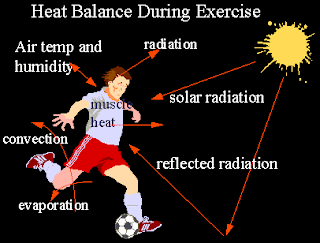Exercise in the heat
by Mr A. E. Hoosen
As people become more aware of the value of exercise, it is important to understand the safety issues surrounding exercise. As we near the summer months, people want to shed those excess centimetres here and there to look good for the beach. As a result more people take to the road to jog or run and even more are in the gyms. In light of the past week we have had in Gauteng
We must first look at the factors that influence heat; conduction, convection, evaporation, radiation, metabolic heat. Conduction is the transfer of heat from one body to another via direct contact, convection is the transfer of heat, radiation is the transfer of heat from one body to another via electromagnetic waves and evaporation is heat loss via the change in phase of water from a liquid to a gas. These factors can either positively or negatively alter heat balance and in combination can result in heat gain or heat loss except for evaporation. Evaporation exclusively favours heat loss and thus promotes cooling. In the case of the exercising individual, sweating is the most important means through which we lose heat, as the sweat formed evaporates from the skin cooling the skin. If the sweat drips off the skin, that potential of the sweat to reduce heat is diminished.
Now that we have identified the factors that influence heat, we need to identify how hot is hot? 23°C on a sunny day vs 23°C on a cloudy and windy day. This is why we use the heat index, to level the playing field as the environmental heat is more than just absolute temperature. We need to take into account; radiation (sun), humidity, air velocity (wind) and air temperature readings in combination. This can provide us with the apparent heat of the day. Apparent
27°C–32°C Exercise can be difficult; enforce rest and hydration
32°C–41°C Heat cramps and exhaustion; be extremely cautious
41°C–54°C Anticipate heat exhaustion; strictly limit activities
54°C and above Setting for heatstroke; seek cool shelter
In order to calculate the apparent temperature one can obtain the current temperature and either dew point temperature or humidity and you can use the online calculator at: http://www.hpc.ncep.noaa.gov/html/heatindex.shtml
How does the body respond to exercise in the heat?
Let us look at the cardiovascular system, the heart pumps blood to the body, and during exercise blood flow is directed to the muscles to meet energy demands, however with exercise the body generates heat and some blood is directed away from the muscles to the skin. This allows the body to dissipate heat via convection, radiation and evaporation. However in the heat the body transfers more blood to the skin to accelerate heat loss in an attempt to keep cool, this results in the heart speeding up the rate of pumping, and results in a phenomenon called cardiovascular drift. Cardiovascular drift is whem heart beats so fast that instead of pumping out more blood, less blood is pumped per beat.
The second means of dissipating heat is through sweat loss. Sweat production draws from the water located in the plasma of the blood. When one exercises for a prolonged period of time without replacing fluids, the blood becomes more viscous, resulting in less blood being able to pass through the body reducing the supply of oxygen and nutrients to the muscle. These two factors can hamper performance and can in combination pose a health risk.
Guidlines to Exercise in the heat:
1. Exercise in the mornings and evenings.
2. Drink plenty of fluids even when not thirsty every 15-30minutes (Isotonic replacement)
3. Clothing
a. Clothing that allows ventilation
b. Wear light coloured clothes
c. Cover small surface area of the body (expose maximum surface area)
d. Hats for extreme sunlight
4. Utilise sunblock
5. Avoid exercise when heat index is 32oC or more
6. Avoid consuming salt tablets or foods high in salt
WARNING SIGNS OF HEAT EXHAUSTION
- Heavy sweating
- Fatigue
- Headache
- Pale, clammy skin
- Thirst
- Rapid heartbeat
- Dizziness, fainting
- Nausea, vomiting
- Muscle and abdominal cramps
- Mild temperature elevations
If one experiences the following conditions, move to a cooler shady area, drink cool liquids and seek medical attention immediately. Now that summer is at the door step we can now exercise safely


No comments:
Post a Comment